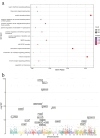Prioritizing drug targets in systemic lupus erythematosus from a genetic perspective: a druggable genome-wide Mendelian randomization study
- PMID: 38997544
- PMCID: PMC11330408
- DOI: 10.1007/s10067-024-07059-3
Prioritizing drug targets in systemic lupus erythematosus from a genetic perspective: a druggable genome-wide Mendelian randomization study
Abstract
Objectives: Systemic lupus erythematosus (SLE) is a heterogeneous autoimmune disease with an unsatisfactory state of treatment. We aim to explore novel targets for SLE from a genetic standpoint.
Methods: Cis-expression quantitative trait loci (eQTLs) for whole blood from 31,684 samples provided by the eQTLGen Consortium as well as two large SLE cohorts were utilized for screening and validating genes causally associated with SLE. Colocalization analysis was employed to further investigate whether changes in the expression of risk genes, as indicated by GWAS signals, influence the occurrence and development of SLE. Targets identified for drug development were evaluated for potential side effects using a phenome-wide association study (PheWAS). Based on the multiple databases, we explored the interactions between drugs and genes for drug prediction and the assessment of current medications.
Results: The analysis comprised 5427 druggable genes in total. The two-sample Mendelian randomization (MR) in the discovery phase identified 20 genes causally associated with SLE and validated 8 genes in the replication phase. Colocalization analysis ultimately identified five genes (BLK, HIST1H3H, HSPA1A, IL12A, NEU1) with PPH4 > 0.8. PheWAS further indicated that drugs acting on BLK and IL12A are less likely to have potential side effects, while HSPA1A and NEU1 were associated with other traits. Four genes (BLK, HSPA1A, IL12A, NEU1) have been targeted for drug development in autoimmune diseases and other conditions.
Conclusions: .This study identified five genes as therapeutic targets for SLE. Repurposing and developing drugs targeting these genes is anticipated to improve the existing treatment state for SLE. Key Points • We identified five gene targets of priority for the treatment of SLE, with BLK and IL12A indicating fewer side effects. • Among the existing drugs that target these candidate genes, Ustekinumab, Ebdarokimab, and Briakinumab (targeting the IL12 gene) and CD24FC (targeting HSPA1A) may potentially be repurposed for the treatment of SLE.
Keywords: Drug target; Expression quantitative trait loci; Genetics; Mendelian randomization; Systemic lupus erythematosus.
© 2024. The Author(s).
Figures




Similar articles
-
Mendelian randomization analysis identifies druggable genes and drugs repurposing for chronic obstructive pulmonary disease.Front Cell Infect Microbiol. 2024 Apr 10;14:1386506. doi: 10.3389/fcimb.2024.1386506. eCollection 2024. Front Cell Infect Microbiol. 2024. PMID: 38660492 Free PMC article.
-
Mendelian randomization analysis revealed potential causal factors for systemic lupus erythematosus.Immunology. 2020 Mar;159(3):279-288. doi: 10.1111/imm.13144. Epub 2019 Nov 21. Immunology. 2020. PMID: 31670388 Free PMC article.
-
Prioritizing endocrine-disrupting chemicals targeting systemic lupus erythematosus genes via Mendelian randomization and colocalization analyses.Ecotoxicol Environ Saf. 2025 Apr 15;295:118126. doi: 10.1016/j.ecoenv.2025.118126. Epub 2025 Apr 3. Ecotoxicol Environ Saf. 2025. PMID: 40185033
-
A review of genetic risk in systemic lupus erythematosus.Expert Rev Clin Immunol. 2023 Jul-Dec;19(10):1247-1258. doi: 10.1080/1744666X.2023.2240959. Epub 2023 Jul 26. Expert Rev Clin Immunol. 2023. PMID: 37496418 Review.
-
Mendelian randomization and clinical trial evidence supports TYK2 inhibition as a therapeutic target for autoimmune diseases.EBioMedicine. 2023 Mar;89:104488. doi: 10.1016/j.ebiom.2023.104488. Epub 2023 Feb 24. EBioMedicine. 2023. PMID: 36842216 Free PMC article.
References
MeSH terms
Substances
LinkOut - more resources
Full Text Sources
Medical
Miscellaneous

